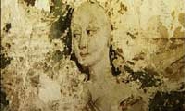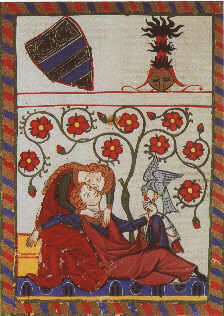Category — Medieval Art
The Painted Lady of Wells
 Earlier this year a medieval mystery story from the 15th century made headlines in the popular press. From the BBC:
Earlier this year a medieval mystery story from the 15th century made headlines in the popular press. From the BBC:
A mysterious medieval wall painting found beneath the floor of the Bishop of Bath and Wells’ bedroom has given up its secrets.
The painting, which shows a partly-clad woman wearing a transparent dress, dates from between 1460 and 1470.
It was part of the decoration of the throne room of Bishop Thomas Beckynton.
Dr Mark Horton, of Bristol University, who researched the painting discovered it is most likely to be part of a scene representing a medieval paradise.
Dr. Horton was able to identify and estimate the date of the painting because a dipiction of the room with the painting was discovered in a medieval manuscript. Dr Horton said:
The amazing thing is that this medieval manuscript accurately records what was on the wall. This included details of foliage and fruits which we then were able to find behind the heating pipes next to the image of the lady. It was rather like something out of the Da Vinci Code, creeping beneath the bishop’s floorboards to come face to face with this incredible piece of medieval art.
I think it’s a much better beginning for book than the Da Vinci code. Imagine where a naked lady on the wall of a 15th century Bishop’s throne room could take you.
[tags]Lady of Wells, medieval art, medieval manuscript, Mark Horton, medieval mystery[/tags]
November 14, 2006 Comments Off on The Painted Lady of Wells
Heloise ca.1100-ca.1163

Heloise
Suggested Reference for further study;
Furlong, Monica, Visions and Longings; Medieval Women Mystics, Shambhala Publications, 1996.
Heloise was an exceptional women who was educated beyond virtually all but a select few. She read and wrote in Latin, Greek and Hebrew. This is rare in today’s world and all but unheard of in her day.
Heloise is best known for her love affair with Pierre Abelard. When Heloise was 17, Abelard, a noted if not notorious intellectual of the period, became her tutor. They quickly became lovers. Abelard wrote that after a chaste life he decided to seduce a woman and Heloise was convenient for his purpose. We’ll never know if this is the truth or common male vanity. Whatever the circumstance, the affair became widely known in Paris and Heloise became pregnant. Abelard ferried Heloise to the safety and seclusion of his family in Britanny where she bore a son, Pierre Astrolabe. Abelard offered marriage but Heloise refused. She wished to live with him as long as it pleased both of them to do so. From Furlong,
“She insisted that it filled her with pride to be Abelard’s whore, as she put it–she asked no more of life. “
There was finally a secret marriage and Heloise was imprisoned in a nunnery where she became prioress of Argenteuil. Abelard was attacked and castrated. Afterwords, he became a monk. Basically, Abelard betrayed her in every way possible and castration was a minor punishment for his deceits. Heloise, on the other hand, was a woman of great intellect obsessed with an older man she never truly knew.
Ideas for further reading:
The Letters of Heloise and Abelard
Heloise and Abelard: A New Biography
[tags]heloise, abelard, medieval woman, medieval history, 12th century[/tags]
November 5, 2006 Comments Off on Heloise ca.1100-ca.1163

